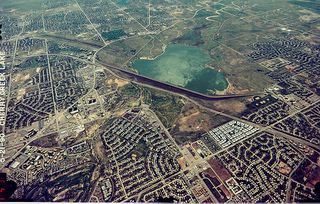She used the following slide from a U.S. Army Corps of Engineers website:

Socio-economic decisions and human rationality

The picture shows Cherry Creek Lake in Colorado, formed by a Corps of Engineers dam. The dam was built in the late 1940's as a flood control measure on one of the tributaries to the Platte River. As you can see, there is a housing development right below the dam.
The housing was put in after the dam, so clearly a hazard assessment was made explicitly by the developer and somewhat more implicitly by the buyers. A later review of the dam by the Corps revealed that the structure needed reinforcing to avoid a catastrophic collapse, which obviously would be somewhat hazardous to a few of the houses shown.
But no, the neighbourhood objected, and fought the planned reinforcement because it would be disruptive and detract from the views. A private consultant was hired to re-evaluate the threat, and the Corps' project was de-funded through Congressional action. The dam remains unreinforced.
The fact remains that both studies indicate there is a probability of an extraordinary rain event causing a collapse. Of course, there always will be this probability, no matter what kind of dam you build, because there is never a 100% guarantee. The private contractor came up with a lower risk assessment - this 'reinforced' arguments that the Corps was simply fishing for work, and doing it in neighbourhoods that were not organized enough to fight off such attempts. There was not much discussion by the community of the absolute level of risk indicated by the second study; most of the debate focused on the relative differences. The issue really is one of risk perception - the local community was willing to live with a level of risk higher than that originally estimated for the dam design, but judged to still be within the overall design parameters.
The real indicator of course, will be the insurance rates.
...but they too can be influenced by pressures that do not have much to do with real risk. Nearby Ft. Collins tried to revise its rainfall models using the latest data and analyses in 1997, but the expansion in the designated 100-year floodplain this would have implied caused a political uproar. The community decided to use the less accurate map because it preserved property values.
In the end, decisions are made based on emotions. Science is simply one input among many - and its refusal to use emotional leverage is perhaps a political weakness.
This picture, for one, was not used in public debate. It should have been - it tells the story pretty well, even without someone giving it the context of cold hard facts, and anecdotal recollections.
No comments:
Post a Comment